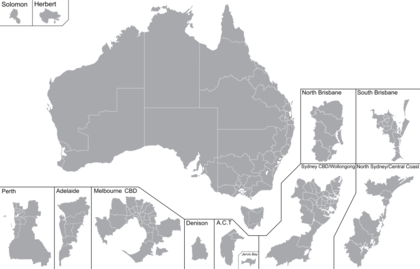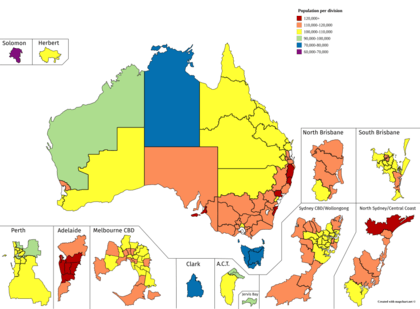Divisions of the Australian House of Representatives
In Australia, electoral districts for the Australian House of Representatives are called divisions or more commonly referred to as electorates or seats. There are currently 151 single-member electorates for the Australian House of Representatives.


Constitutional and legal requirements
Section 24 of the Constitution of Australia requires that the total number of members of the Australian House of Representatives shall be "as nearly as practicable" twice as many as the number of members of the Australian Senate. The section also requires that electorates be apportioned among the states in proportion to their respective populations; provided that each original state has at least 5 members in the House of Representatives, a provision that has given Tasmania higher representation than its population would justify. There are also three electorates in the Australian Capital Territory and two in the Northern Territory.
In addition, Section 29 forbids electorate boundaries from crossing state lines, forcing populated areas along state and territory borders to be placed in different electorates, such as Albury in New South Wales being part of the electorate of Farrer, while nearby Wodonga in Victoria is part of the electorate of Indi. The same restriction does not apply to territories, and several current electoral divisions incorporate electors from multiple territories. This is currently the case for the Division of Bean (covering part of the ACT and the whole of Norfolk Island), the Division of Fenner (covering part of the ACT and the whole of Jervis Bay Territory), and the Division of Lingiari (covering part of the Northern Territory and the whole of Christmas Island and Cocos (Keeling) Islands).
The Commonwealth Electoral Act 1918 sets out further provisions.[1]
Apportionment
The Australian Electoral Commission (AEC) determines from time to time the number of members to which each state and territory is entitled and the boundaries of each electorate, in a process known in Australia as redistribution.
Within each state and territory, electoral boundaries are redrawn from time to time. This takes place at least once every 7 years, or when the state's entitlement to the number of members of the House of Representatives changes. Boundaries are drawn by a Redistribution Committee, and apportionment within a state is on the basis of the number of enrolled voters rather than total residents or "population".
The number of enrolled voters in each division cannot vary by more than 10% from the average across a state or territory, nor can the number of voters vary by more than 3.5% from the average projected enrolment 3.5 years into the future. However, due to various reasons, larger seats like Cowper (New South Wales) contain 80% more electors than that of smaller seats like Solomon (Northern Territory).
The last redistribution was completed in 2018, in time for the 2019 federal election. In this redistribution, the AEC added a seat to Victoria and the Australian Capital Territory, and also determined that South Australia would lose a seat. The total number of seats in the House of Representatives therefore increased to 151. Seats in Victoria, Tasmania and South Australia were also abolished, in order to make way for seats in similar locations but with different names.[2][3]
Naming
The Divisions of the House of Representatives are unusual in that many of them are not named after geographical features or numbered, as is the case in most other legislatures around the world. Most Divisions are named in honour of prominent historical people, such as former politicians (often Prime Ministers), explorers, artists and engineers.
In some cases where a Division is named after a geographical locality, the connection to that locality is sometimes tenuous. For instance, the Division of Werriwa, created in 1901, was named after the Aboriginal word for Lake George in the Canberra region. However, Werriwa has not contained Lake George for many decades, and has steadily moved some 200 km north to the south-western suburbs of Sydney over the past century.
List of Divisions in 2019
The lists below show the Divisions as they exist at the 2019 Australian federal election.
New South Wales
There are 47 Divisions in New South Wales:
|
|
|
|
Victoria
There are 38 Divisions in Victoria:
|
|
|
|
Queensland
There are 30 Divisions in Queensland:
|
|
|
|
Western Australia
There are 16 Divisions in Western Australia:
|
|
|
|
South Australia
There are 10 Divisions in South Australia:
|
|
|
|
Tasmania
There are 5 Divisions in Tasmania:
|
|
Australian Capital Territory
There are 3 Divisions in the Australian Capital Territory:
|
Northern Territory
There are 2 Divisions in the Northern Territory:
|
Abolished divisions
These Australian Divisions no longer exist:
- Angas (1903–34) (SA)
- Angas (1949–77) (SA)
- Australian Capital Territory (1949–74) (ACT)
- Balaclava (1901–84) (VIC)
- Barrier (1901–22) (NSW)
- Batman (1906–2019) (VIC)
- Bland (1901–06) (NSW)
- Bonython (1955–2004) (SA)
- Bourke (1901–49) (VIC)
- Burke (1949–55) (VIC)
- Burke (1969–2004) (VIC)
- Canobolas (1901–06) (NSW)
- Charlton (1984–2016) (NSW)
- Cook (1906–55) (NSW)
- Coolgardie (1901–13) (WA)
- Corinella (1901–06) (VIC)
- Corinella (1990–96) (VIC)
- Dalley (1901–69) (NSW)
- Dampier (1913–22) (WA)
- Darebin (1949–69) (VIC)
- Darling (1901–77) (NSW)
- Darling Downs (1901–84) (QLD)
- Darwin (1903–55) (TAS)
- Denison (1903–2019) (TAS)
- Diamond Valley (1969–84) (VIC)
- Dundas (1977–93) (NSW)
- East Sydney (1901–69) (NSW)
- Echuca (1901–37) (VIC)
- Evans (1949–77) (NSW)
- Fawkner (1906–69) (VIC)
- Fraser (1974–2016) (ACT)
- Grampians (1901–22) (VIC)
- Gwydir (1901–2007) (NSW)
- Hawker (1969–93) (SA)
- Henty (1913–90) (VIC)
- Higinbotham (1949–69) (VIC)
- Hoddle (1949–55) (VIC)
- Illawarra (1901–22) (NSW)
- Isaacs (1949–69) (VIC)
- Kalgoorlie (1901–2010) (WA)
- Laanecoorie (1901–13) (VIC)
- Lang (1901–77) (NSW)
- Lawson (1949–69) (NSW)
- Lowe (1949–2010) (NSW)
- Martin (1922–55) (NSW)
- McMillan (1949–2019) (VIC)
- Melbourne Ports (1901–2019) (VIC)
- Mernda (1901–13) (VIC)
- Moira (1901–06) (VIC)
- Murray (1949–2019) (VIC)
- Namadgi (1996–98) (ACT)
- Nepean (1906–22) (NSW)
- Northern Melbourne (1901–06) (VIC)
- Northern Territory (1922–2001) (NT)
- Oxley (1901–34) (QLD)
- Parkes (1901–69) (NSW)
- Phillip (1949–93) (NSW)
- Port Adelaide (1949–2019) (SA)
- Prospect (1969–2010) (NSW)
- Riverina-Darling (1984–93) (NSW)
- Scullin (1955–69) (VIC)
- South Australia (1901–03) (SA)
- South Sydney (1901–34) (NSW)
- Southern Melbourne (1901–06) (VIC)
- St George (1949–93) (NSW)
- Streeton (1984–90) (VIC)
- Tasmania (1901–03) (TAS)
- Throsby (1984–2016) (NSW)
- Wakefield (1903–2019) (SA)
- Watson (1934–69) (NSW)
- West Sydney (1901–69) (NSW)
- Wilmot (1903–84) (TAS)
- Wimmera (1901–77) (VIC)
- Yarra (1901–69) (VIC)
See also
- List of members of the Australian House of Representatives
- Australian electoral system
References
- "Research Report 4 – Australian Federal Redistributions 1901–2003: The Redistribution process". aec.gov.au. Australian Electoral Commission. 30 May 2013. Retrieved 5 May 2008.
- "Determination of membership entitlement to the House of Representatives". aec.gov.au. Australian Electoral Commission. 31 August 2017. Retrieved 20 July 2018.
- Green, Antony. "2017-18 Federal Redistributions". abc.com.au. Australian Broadcasting Corporation. Retrieved 20 July 2018.
